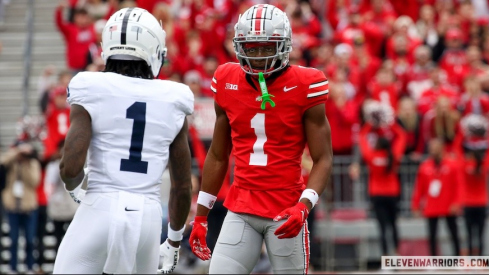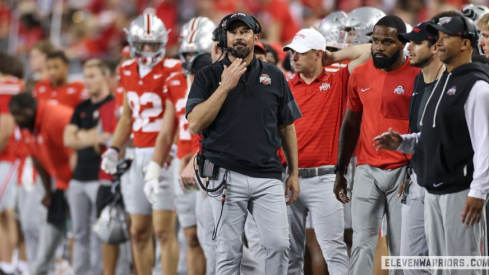
After a season of troubling signs from the Ohio State pass defense, the dam broke Saturday.
Once again, an opposing offense set season high in passing yards against the Buckeye defense and, once again, the Buckeye defense was undone by fundamental breakdowns. The difference against Michigan State was that the Buckeye offense could not overcome the defensive liabilities.
The Buckeyes' Achilles heel in the first half Saturday was coverage lapses that allowed explosive plays, often for touchdowns.
Then, just when it seemed the Buckeye defense settled in, cornerback Bradley Roby left with a knee injury and what was left of the Buckeye secondary had no shot at stopping the Spartans. Continued breakdowns in basic coverage responsibilities allowed Michigan State to grab a lead and not let go.
Below I analyze how and perhaps why the 2013 Ohio State defense continually failed against the pass.
Winning Straight up ...
Michigan State did not employ anything particularly tricky against the Buckeyes. Although Michigan State did utilize calls Michigan exploited the week before – such as speed option to the boundary or weak screens – to Ohio State's credit they were more fundamentally sound on the edge and limited gains from such plays.
And the Buckeyes largely bottled up Jeremy Langford and Michigan State's run game. Granted, Langford topped 100 yards, but much of that came on the Spartans' final drive. Given that Michigan State was such a run-heavy team all season long, rendering the Spartans one-dimensional would have seemed like a recipe for success.
With Beaters
But such a theory was quickly discredited, as Connor Cook gashed Ohio State through the air. Michigan State did so with a pro-style passing game that systematically attacked Ohio State's coverage schemes.
For instance, the Buckeyes played a great deal of cover 2, particularly in second and third and long situations. The Spartans exploited the Buckeye cover 2, however, with smash and snag routes to the deep outside.
As Chad discussed, statistically this season the Buckeyes have limited explosive pass plays of 20+ yards, while being vulnerable to gains between 10-20 yards. If Ohio State had only continued this trend against Michigan State, they may have been ok. Instead, the Buckeyes allowed numerous explosive pass plays, including two longer than 50 yards, all of which led to points.
For instance, below Michigan State packages mesh with a smash variation combining a corner and swing route. The goal is to put a man beater to the boundary and a hi-lo stretch to the field against a cover 2 corner.

At the snap, Cook reads cover 2, so he knows he is going to the wide side of the field, where he has the 2 on 1 against the squat corner. Cook knows that the corner must cover the swing to the wide side flat, and he can throw the flag pattern before the cover 2 safety can react.
So Michigan State has a good call against the Buckeye coverage. But a completion is one thing. Throwing gasoline on the fire, Corey Pitt Brown takes a horrible angle, coming under the throw and violating a cover 2 safety's primary rule, which is not get beat deep. Seventy-two yards later Michigan State was up 10-0.

The Buckeyes suffered a similar basic breakdown in the fourth quarter. Here, Michigan State runs a post-corner combination. But now, Ohio State is in cover 3. So they should be able to cover the routes, with the middle of the field safety taking the post and the deep-third cornerback taking the flag route.

Unfortunately, backup Armani Reeves follows the post route, leaving the corner route wide open for another big play.

And here it is, in action:

Reeves compounded the breakdowns on the same drive when he allowed an easy touchdown throw by mistakenly playing man coverage when the rest of the defense was in a cover 3 blitz. This proved to be the decisive score off a back-breaking, 90 yard drive. It was unfortunately not the first time Reeves made this mistake.

The Straw that Broke the Camel's Back
It is not coincidental that Michigan State engineered this drive once Reeves entered for an injured Roby. In keeping with the theme of the dam breaking, in hindsight Reeves' entry likely removed any chance for the Buckeye defense to restrain the Spartan passing game.
After spotting Michigan State to a 17-0 lead, the Buckeye defense stiffened, allowing Ohio State to claw back to a 24-17 lead. But the turning point came on the play Roby was injured. Ohio State went from a potential turnover bouncing off Roby's chest, to him leaving the game. The Spartans promptly reeled off 10 points in Roby's absence.
In some ways this was emblematic of the Buckeye defense all season. Strong individual play and performances were drowned out by glaring weaknesses in scheme and execution. Roby and Joey Bosa played at a high level all Saturday. Bosa manhandled single blocking, particularly when Michigan State tried to handle him with a tight end.
More broadly, the defensive line as a whole played well but did not play at the level needed for the Buckeye defense to succeed. For instance, Noah Spence continues to struggle maintaining edge support at the point of attack.
But that is a relatively minor issues compared to the massive deficiencies in the Buckeye defensive back seven. So much is put on a young defensive line because it is the Buckeyes' only chance against the pass.
The reality is that significant holes exist, and have existed all season, in both the linebacker corps and secondary. As discussed, Ohio State only has three healthy non-freshman linebackers that should ever see the field, and two of those – Josh Perry and Curtis Grant – have had their struggles in pass coverage.
But the Buckeye defensive backfield is nearly as thin. Ohio State has two solid corners in Roby and Doran Grant, but are weak elsewhere and lack depth. The loss of Christian Bryant turned the Buckeye safety play into another weakness. CJ Barnett is solid in run support but weak against the pass. Brown was in no way qualified to take Bryant's spot. In hindsight, Luke Fickell and Everett Withers should have played a young player such as Vonn Bell in Bryant's absence (or moved Powell to safety with Bell at nickel), but at the time the defensive coaching staff was probably trying to triage the problem as best they could. But Brown never played at a functional level. Between the linebackers and safeties the Buckeye defense was left extremely weak up the middle, in direct contradiction to Urban Meyer's mantra that a good defense must be strong up the gut.
The defensive weaknesses were only magnified without Roby. Ohio State is in the same position at corner as at safety. After their starters, the Buckeyes had only freshman and/or players unprepared to play.
As such, once Roby left the field, the Buckeyes had little chance with Brown and Reeves in the backfield.
Who Are You?
But accepting the above personnel limitations does not absolve the coaching staff. Such massive breakdowns in basic coverage principles ultimately reside with the players, but it is troubling that such issues continue to rear their head, even with backups.
In the bigger picture, the game again begged the question of what, exactly, is Ohio State's defensive identity. For example, the Buckeyes played a sizeable amount of cover 2 against Michigan State; after using the coverage sparingly throughout the year. This was emblematic, as the season was replete with examples of altering schemes week to week. The charitable explanation is, given the personnel issues explained above, the coaching staff is seeking some formula that works. But one can only assume such variety in schemes is in part contributing to certain breakdowns.
The ultimate result is that the defense as a unit does not have a formula that the defense as a program can hang its hat on, continually rep, and believe in when it needs a stop. One only needs look across the field to Michigan State to see an opposite approach, where an experienced unit has spent years learning and repping the intricacies of Pat Narduzzi's 4-3 over cover 4.
Pulling it Together
In all likelihood, Ohio State's defensive was not championship caliber and the Buckeyes were living on borrowed time. Going forward, is difficult to imagine such systemic breakdowns being completely fixed by the Orange Bowl. The hope in the long run is that the Ohio State defense can grow with their young, talented personnel, and develop a defensive identity.

